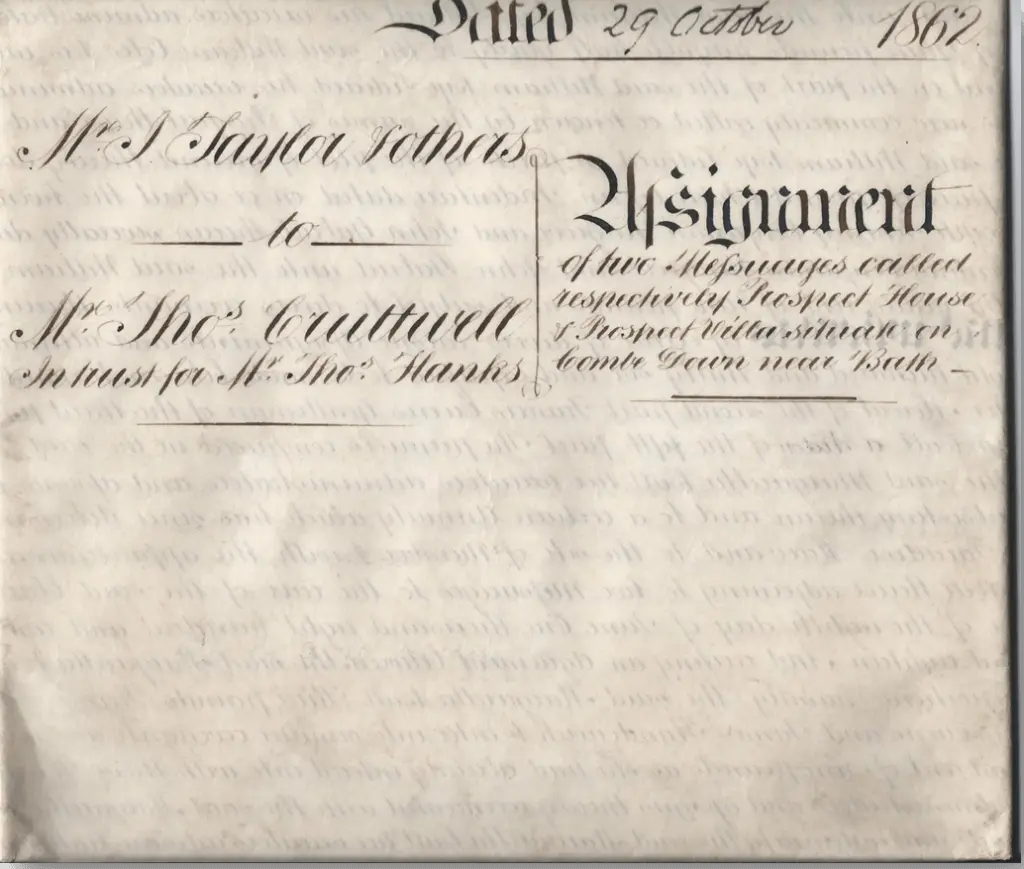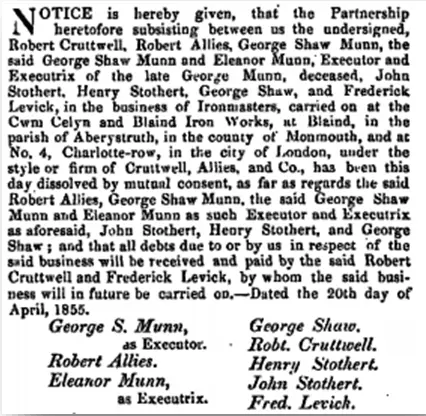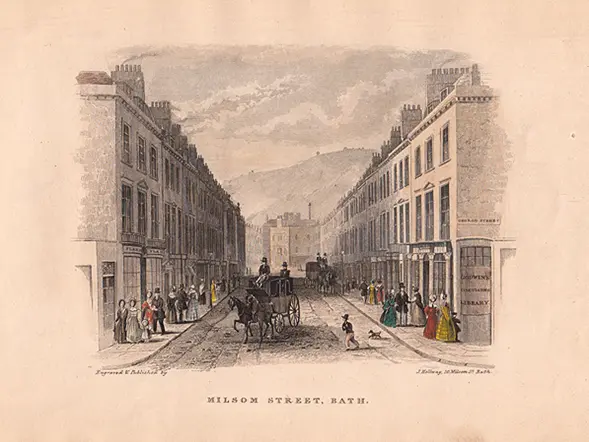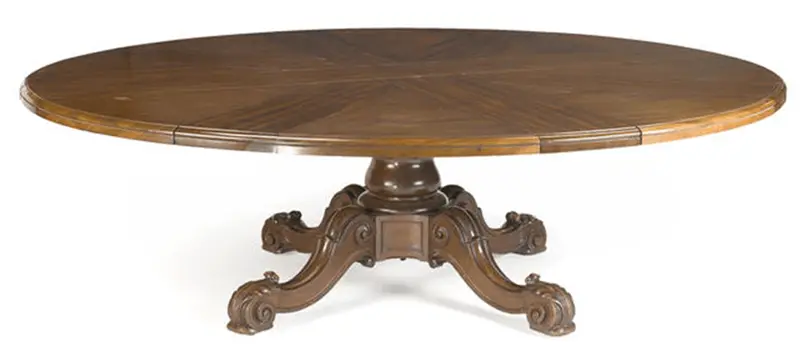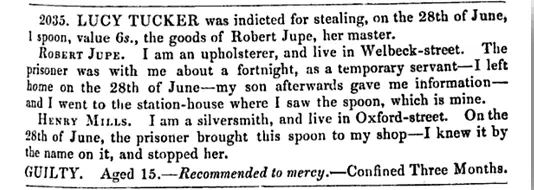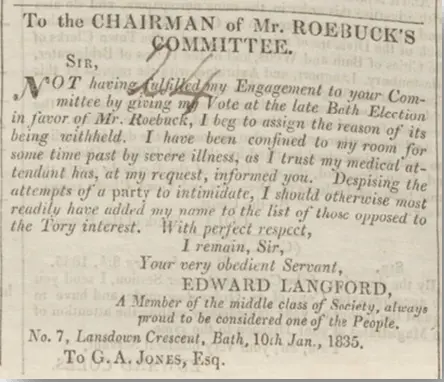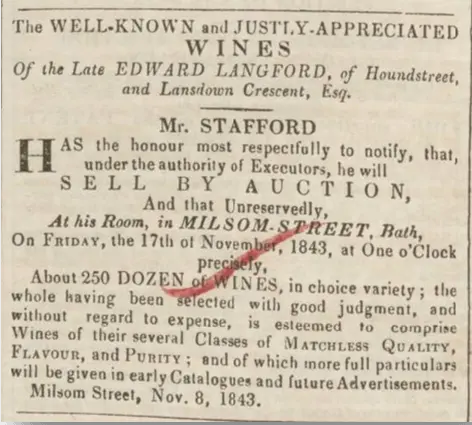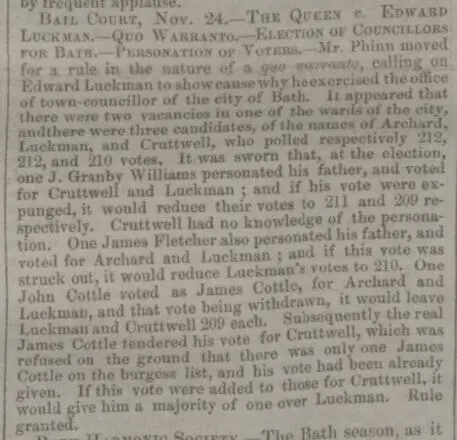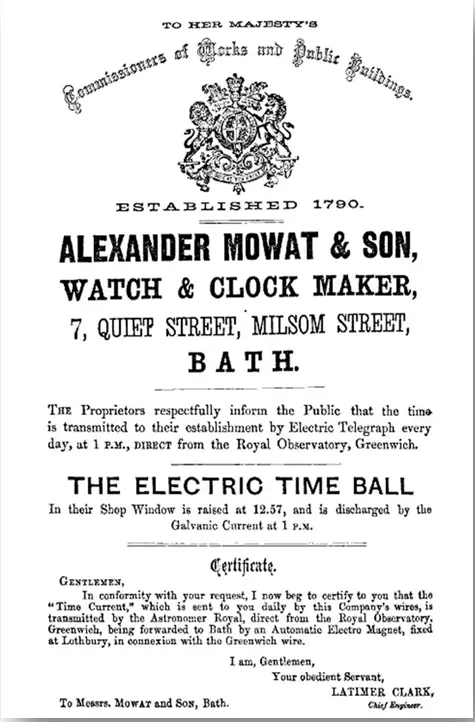Almost everything we know about the owners and occupants of 109 – 117 Church Road comes from the deeds, but there are very useful additions from other sources.
Certainly 115 and 117 were both initially owned or mortgaged, probably in 1805 – 1806, by Joseph Ponting, Benjamin Wingrove & John Gabriel. This is known from the recitation in a deed dated 29th October 1862 being an:
“Assignment of two Messuages called respectively Prospect House and Prospect Villa situate on Combe Down near Bath”.
That recitation says:
“Indenture dated on or about the twenty first day of June One thousand eight hundred and eighteen and expressed to be made between Joseph Ponting, Benjamin Wingrove & John Gabriel therein severally described of the one part and the said William Coles of the other part”.
So, in 1818 115 and 117 Church Road were passed from Joseph Ponting, Benjamin Wingrove & John Gabriel to William Coles who was a carpenter.
We have already touched on Benjamin Wingrove, but who were Joseph Ponting and John Gabriel?
Joseph Ponting – 115 & 117
We know Joseph Ponting was a Captain in the Somerset Yeomanry as he appears as such alongside Benjamin Wingrove in the London Gazette of February 26th 1805.
There is also a J / Jos / Josh Ponting who appears in the UK Land Tax Redemption 1798 for a range of properties in Norton St. Philip, Wellow and Woolley, who would seem to be a good candidate.
The will of a Joseph Ponting of the manor of Monkton Farleigh and Cumberwell dated 1822 in Wiltshire & Swindon Archives[1] seemed likely to help but, apparently, has been misplaced.
Thus I have been unable to establish whether they are all the same man and the man who appears in the deed, though it would seem likely.
John Gabriel – 115 & 117
John Gabriel (1787-1825) was, almost certainly, the solicitor who was a partner in Atherton & Gabriel in Calne but his father was also called John Gabriel (1743-1824).
As the son was more of a contemporary of Benjamin Wingrove perhaps he is the more likely?
Atherton and Gabriel were solicitors and were also involved with the Calne, Hilmarton and Lyneham Turnpike Trust so those are both ways that Benjamin Wingrove could have come to know John Gabriel.
Additionally, Nathan Atherton became an owner of 113 in 1861 and his daughter Sabina Pool Atherton (1828 – 1913) married Charles Henry Gabriel (1821 – 1900) who was John Gabriel’s son.
William Coles – 115 & 117
Other than that he was a carpenter, I have been unable to establish more about William Coles.
Elias Dyer – 115 & 117
On 1st June 1819 there is an:
“Indenture of Mortgage from the said William Coles to Elias Dyer”.
Elias Dyer (1779 – 1852) was a baker and corn factor known to be trading, in 1822[2], 1841[3] and 1848[4], from 32 Walcot Street.
He was also a churchwarden of St. Michaels and appears as such in an article in Bath Chronicle and Weekly Gazette on Thursday 2nd October 1834 about the plans for the rebuilding of the church. He also owned land out at Bailbrook.
We know that Elias Dyer was also a shareholder in the Wilts & Dorset Bank[5] and involved in railway development as the following from 9th March 1846 shows:
“A Petition of Elias Dyer, praying that his Petition, complaining that the Standing Orders of the House, in respect to the application for the Bristol and Birmingham Railway (Bath Line) Bill, had not been complied with, may be withdrawn, was presented, and read; and referred to the Select Committee on Petitions for Private Bills”.
However, it seems that not everything was as it should have been and some skulduggery seems to have taken place as, on 25th March, we have:
“A Petition of George Byng Paget one of the directors of the Midland Railway Company, and one of the Promoters of the Bill thereinafter mentioned, was presented, and read ; setting forth, That a Petition has been presented to the House for leave to bring in a Bill for making a Railway from the Bristol and Gloucester Railway, at Mangotsfield, to Bath, which Petition has been referred to the Committee on Petitions for Private Bills; that on the tenth day of February last, a Petition was presented to the House purporting to be signed by Thomas Wintle, and certain other owners and occupiers of lands whose names are thereunto annexed, alleging certain non-compliances with the Standing Orders of the House; that the Petitioner is informed and believes that the signature of Elias Dyer, affixed to the said Petition, was affixed to the piece of parchment containing only the prayer thereof, and no other part of the said Petition, and that the contents of the said Petition were not communicated to him or to the other Petitioners before the presentation thereof to the House; that the Petitioner submits that such proceedings with reference to such Petition are irregular and inconsistent with the rules and orders of the House, and that the said Petition ought not, under the circumstances, to be entertained by the said Committee; and praying that he may be heard, by his agents and witnesses, before the said Committee, in support of the allegations hereinbefore contained, and that the said Petition of the said Thomas Wintle and others may not be entertained by the said Committee, or that such other order may be made in the premises as to the House shall seem meet. Ordered, That the said Petition be referred to the Select Committee on Petitions for Private Bills”. [6]
A bill to build the line eventually passed in 1864 and the line was opened in 1869.
We have a description of a part of Combe Down in 1819 from Pierce Egan (1772–1849) who was a journalist, sportswriter and writer on popular culture:
“At Isabella-Place, which is but a short distance from this rural spot, one of the finest views for extensive scenery that can possibly be imagined bursts upon the already de lighted traveller: the immense chain of high hills, as far as the eye can stretch, have a grand and majestic appearance. On the left is Salisbury-Plain; next appears Warminster, and the White Horse cut out of the turf at Westbury under the plain, in Wiltshire, is seen without any difficulty. In the centre stands the unrivalled seat of the Marquis of Bath, called Longleat, the fine park and woody appearance of which tends to increase the beauty of the surrounding prospect; and the perspective view of Alfred's tower, erected on the abrupt termination of a very lofty hill, belonging to Sir Richard Colt, Bart, gives an interesting finish to this charming expanse of country. When the fascinated spectator can remove from this brilliant panoramic spectacle, he will pass Prospect-Place, a very neat row of houses, and which very properly merits its title. Byfield-Buildings is also as pleasantly situated, and a few paces forwards the visitor, if inclination permit him, may descend into the stone-quarries at Combe-Down, opened and worked by Mr. Allen. This sudden contrast is extremely pleasing: the vast depth of freestone which has been excavated from the earth; the lofty arches, or pillars, remaining in a craggy state, left by the excavators to let in light to the subterraneous passages and caverns which extend for a considerable way under the earth, most interestingly claim the attention of the explorer”. [7]
From this it’s clear that Byfield Buildings and Prospect Place were in existence by 1819. As 113-117 Church Road also appear, from the 1836 advert above, to have been called 1 & 2 Prospect Place, this is somewhat confusing.
William Bye Lidiard – 115 & 117
In 1820 William Bye Lidiard became a mortgagor for 115 and 117 Church Road in an:
“Indenture dated on or about the eighth day of April One thousand eight hundred and twenty and expressed to be made between William Coles and Elias Dyer of the one part and William Bye Lidiard Gentleman of the other part”
William Bye Lidiard (1789-1858) was a Conveyancer and must have been known to Benjamin Wingrove. They appear in the same directory as conveyancers. He had offices in New King Street and later Corn Street and then 3 Wood Street and lived at 2 Norfolk Crescent.
In 1821 he suffered a family tragedy. A runaway horse killed one of his children. It’s not clear, however, which of his children was killed. It seems likely to have been his daughter Sarah Louisa who had been born in 1814 as we can account for all his other children alive at the time of the accident.
In December of 1820 there is an advert in the Chronicle about an auction to be held for 2 messuages, and some land on which another house could be built, on Combe Down near the Carriage Inn, though it’s not clear exactly which houses these are.
Francis Ewens – 113, 115 & 117
On 30th December 1825 it seems that William Coles and Elias Dyer were transferring their mortgage interest in 115 and 117 to Francis Ewens as there is an:
“Indenture of Assignment from the said William Coles and Elias Dyer to Francis Ewens of London Gentleman”
Francis Ewens has been very difficult to track down. The issue is, partially, the ‘of London’ part of the phrase, as it’s very little to go on and could just mean he was living there for a while.
There was a Mr. W. Ewens who operated from Westgate Street as an ironmonger and placed a lovely advert in Bath Chronicle and Weekly Gazette on Thursday 3 May 1821 but, clearly that does not help.
However there is a Francis Ewens (1776 – 1853) who was born in ‘Binstick’ (probably Burstock) in Dorset and died in Bath and who in the 1851 census gave his occupation as Gent. Proprietor of Houses, but he was given, in the census return, as a visitor to the house in Walcot. However his will makes clear that he was a licensed teacher.
Other than that he remains somewhat elusive, for, although his will lists many members of his family, I have, thus far, been unable to track them down. We do know that Francis Ewens also had an interest in 113 (then called Paradise House) as on 30 August 1849:
“By Indenture of this date made between Francis Ewens of Combe Down in the County of Somerset of one part and Edward Palethorpe of the same place Gent: of other part……”
He sold it for £230. On the same date there was also an Indenture of Assignment made from the said Francis Ewens to the said Edward Palethorpe made for the mortgage for 115 and 117.
We also know from The Bath Chronicle on 11 October 1849 that he was living at 113 when his wife Betty died:
One has to wonder whether the events of selling 113 and his interest in the mortgage for 115 and 117 and the death of his wife are correlated? Did he know his wife was dying and thus sell or was it just a coincidence?
Moving back in time there was on 30th June 1834 an Indenture of Assignment made between the said Francis Ewens of the first part, Ambrose Heale Esquire of the second part and Thomas Macaulay Cruttwell Gentleman of the third part, from which it would seem that Ambrose Heal and Thomas Macaulay Cruttwell took on some of the mortgage on 115 and 117 from Francis Ewens.
Ambrose Heal – 115 & 117
Ambrose Heal’s (1779 – 1837) grave can be found in the churchyard of St. Michaels in Monkton Combe. He was the son of Ambrose Heal (1748 – 1812) of Gillingham in Dorset, who owned lands there. His grandfather John was born in Maiden Bradley.
His brother was John Harris Heal (1772 – 1833) who founded Heals of Tottenham Court Road the store and furniture makers.
Ambrose Heal’s daughter Ann Standerwick Heal (1810 – 1890) married her cousin John Harris Heal (1811 – 1876) who was John Harris Heal’s (1772 – 1833) son.
They in turn had a son called Ambrose Heal (1847 – 1913) and he too had a son called Ambrose Heal (1872 – 1959) who was knighted in 1933.
Ambrose Heal (1779 – 1837) spent many years in London in Kentish Town and Soho which are mentioned on his grave and the London Land Tax Records 1692-1932 and, from Dorset Land Tax Returns 1780-1832, he seems also to have received at least some of his father’s property in Gillingham. He also had a house in Gillingham called Newbury House.
In London it seems he worked in partnerships with Roger Rood and Charles Nightingale for many years as can be seen from the extracts from The London Gazette for 1804 and 1830. It seems that at least one venture was in Old Compton Street as bedding warehousemen. Ambrose’s wife Martha Standerwick’s family owned a linen factory in Bourton in Dorset and a bed-tick[8] warehouse in London so this may have been the reason.
This may also have been the reason that John Harris Heal (1772 – 1833) chose mattress making when he set up Heals in 1810.
He had moved to London in 1805 to work with a feather dressing company in Leicester Square.
His idea was to introduce French style feather mattresses to England – a new concept as people were accustomed to sleeping on ticks and thin straw palliasses.
Heals was originally at 33 Rathbone Place, London but, in 1818, they moved to 203 Tottenham Court Road as a ‘Mattress and Feather-bed Manufacturer’. In 1840 Heals moved to 196 Tottenham Court Road – the current site.

Thomas Macaulay Cruttwell – 115 & 117
Thomas Macaulay Cruttwell (1777 – 1848) was the second son of Richard Cruttwell (1747 – 1799) who owned The Bath Chronicle.
Richard Cruttwell was the third child of William and Elizabeth Cruttwell. He was apprenticed to John Carnan, printer, of Elliot’s Court, Old Bailey, London, on 7th April 1761 and became a member of the Stationers’ Company on 4th October 1774. Richard Cruttwell (1747 – 1799) and his brother William had been left property by his great-uncle Richard Cruttwell in 1763 and moved West settling in 1768 at Bath, where he bought a share in the Bath Chronicle.
The Bath Chronicle had started as The Bath Journal in 1843 printed by Thomas Boddely. It soon became Boddely’s Bath Journal and then The Bath Chronicle and Weekly Gazette. In 1761 it was renamed Pope’s Bath Chronicle and Weekly Gazette, then simply Pope’s Bath Chronicle in 1764. In 1768 it became Archer’s Bath Chronicle, then The Bath and Bristol Chronicle later that same year.
In 1770 Richard Cruttwell bought it outright and made it R. Cruttwell’s Bath and Bristol Chronicle, before it became simply The Bath Chronicle just over eight months later.
In the meantime his brother William had moved to Sherborne and established Cruttwell’s Sherborne Journal in late 1764 in opposition to the Sherborne Mercury, founded in 1737 and since January 1749 printed by Robert Goadby, a man with strong Whig sympathies. William Cruttwell remained the proprietor until his death in 1804.
In late 1775, Richard Cruttwell (1747 – 1799) moved The Bath Chronicle to a house on the corner of St James’s and Weymouth streets and prospered as his printing and publishing business developed.
He published, inter alia, John Collinson’s History of Somerset (1791) and two works on Bishop Thomas Wilson edited by his brother the Reverend Clement Cruttwell in 1784 and 1785. He was also one of the earliest publishers to issue local guides and, from 1770 to his death in 1799, he issued annually the New Bath Guide and in 1789 a guide to Cheltenham.
Richard Cruttwell died at Cheltenham on 1 June 1799 and was buried in the family vault beneath St James’s Church, Bath, on 7 June.
Richard Cruttwell’s eldest son (1747 – 1799) Richard Shuttleworth Cruttwell (1775 – 1843) took over The Bath Chronicle and Thomas Macaulay Cruttwell became a solicitor, as did his brother John. They worked in partnership at 5 Westgate Buildings and he lived at Perrymead Lodge.
Thomas Macaulay Cruttwell was responsible for the development of Macaulay Buildings on Widcombe Hill on fields formerly called `The Nedges’. He purchased the ground in 1819, the first house was completed in 1825, the rest were finished by 1830.
He was also involved with the merger that took place in 1839 between the Blaina Ironworks and the newly constructed Cwm Celyn Ironworks. A new company named the Cwm Celyn and Blaina Iron Company was formed to operate both works. There appears to have been an early involvement in this company by the Stothert family and it seems Thomas Macauley Cruttwell also took an important role within their company in its early years. Gwent Archives lists a Deed of settlement for 1 December 1838[9] as follows:
-? 2. John Wheeley Lea of Worcester, chemist, Martin Morrison of Newport, coal master and Henry Stothert of Bath, ironfounder. 3. John Brooke Hyde of Worcester, gent., Joseph Conway of Pontrhydyryn, tin plate manufacturer and Thomas Macaulay Cruttwellof Bath, gent. Reciting the agreement to found a Company with a capital of £80,000 the shares being taken up, intended works already occupied by John Russell and Thomas Brown, ironmasters of Aberystruth, a lease of land, farms and buildings and minerals etc. in Aberystruth from Philip Jones, if necessary the assignment of the Blaina Iron Works. Inauguration of The Cwm Celyn Iron and Coal Co. and articles of Copartnership. Including 1839 October 2. Deed of covenant (copy). The formation of the Cwm Celyn and Blaina Iron Company on 1839 February 23 with a capital of £130,000. 1840 October 5. List of shareholders in Cwm Celyn and Blaina Iron Works. 1844 July 27. Assignment (copy) of Cwmcelyn Ironworks. Cruttwell and Shaw to Francis John Smith Wilson. 1838, 1839, 1840, 1844
On 25th March 1845[10] the Cwm Celyn and Blaina Iron Company was bought by a new grouping of nine partners:
George Munn of Worcester, ironmaster
George Alliss of Worcester, ironmaster
Thomas Macaulay Cruttwell of Bath, gent.
Robert Cruttwell of Bath, gent.
Robert Micklem of Fifield, nr. Maidenhead, Berks., ironmaster
George Shaw of Bath, ironmaster
Joseph Beaumont of the Tump, Monmouthshire, ironmaster
Henry Stothert of Bath, ironmaster
John Stothert of Bath, ironmaster
This also shows his involvement with the Stotherts of Stothert & Pitt fame.
There is also a share certificate for Thomas Macaulay Cruttwell.
Frederick Levick was employed to manage the ironworks. At the Great Exhibition of 1851, the then owners Cruttwell, Allies & Co. displayed pieces of iron forge and refined metal, puddled, merchant and beat bar iron plus a finished rail.
By 1855 the company was operating three furnaces at the Coalbrookvale Ironworks.
In the same year the partnership was dissolved except for Frederick Levick and Robert Cruttwell.[11]
Frederick Levick and Robert Simpson became the owners of the three ironworks in 1858.
The Robert Cruttwell mentioned is Thomas Macaulay Cruttwell’s son who was also a solicitor and who had joined his practice. He died in 1858.
In the 1861 census another of Thomas Macaulay Cruttwell’s sons, and also a solicitor, Thomas Cruttwell (1808 – 1881) is shown to be living at Alma Villa (now Glenburnie) on Combe Down. He was involved with the conveyancing of 115 and 117 Church Road in 1862.
On 21st June 1836, after the auction set for 4th May 1836 noted previously in the advert in the Bath Chronicle, there is for 115 and 117 Church Road an:
“Indenture of Assignment endorsed on the last mentioned Indenture and made between Richard Falkner Banker Robert Jupe Upholsterer and Henry Ward of the first part the said Thomas Macaulay Cruttwell of the second part James Standerwick Gentleman of the third part Margaretta Bull of the fourth part and the said Francis Ewens of the fifth part”.
It is not at all clear from the recitation in the later deed as to who exactly is assigning what to whom but it does bring in a number of new names. I shall leave Margaretta Bull pro tem as she has a bigger part in the story later and we have already heard of Francis Ewens and Thomas Macaulay Cruttwell.
Richard Falkner – 115 & 117
Richard Falkner (1796 – 1863) was a banker and a partner in Tufnell, Collett, Falkner & Co.
This was the successor of a private bank established in Bath in about 1775 as Atwood, Abrahams, Collett, Salmon & Harris. Atwood was a surgeon, William Abrahams a clothier, Isaac Collett a wine merchant, John Salmon an insurance agent and William Harris an ironmonger.
Now it becomes confusing as bank partnerships merged and separated though still give us a trail to the present day.
Atwood, Abrahams, Collett, Salmon & Harris became Tufnell, Stroud, Collett, Payne & Hope from 1810 then Tuffnell, Collett, Payne, Watts & Hope and in 1815 Tuffnell, Collett, Payne & Hope. In 1825 the firm of Tufnell, Collett, Payne & Hope was dissolved and restyled Tufnell, Collett & Co. separating it from Payne & Hope’s Wells Bank (est. 1800, failed 1831) run by the same partners.
Tufnell & Falkner Bank had been set up in 1783. It became Tufnell, Falkner & Falkner from 1812. There was also Tufnell, Collett, Falkner, Ponny & Falkner also known as Bladud Bank. From 1821-1825 there was also a Falkner, Penny and Falkner partnership. From 1829-1835 Falkner, Penny and Falkner became Falkner, Penny, Falkner and Tuffnell. Then Falkner, Penny, Falkner and Tuffnell merged with Tufnell, Collett & Co. and became known as Tufnell, Collett, Falkner & Co. and opened a branch in Chippenham in the 1830s. The partners were Richard Falkner and Francis Henry Falkner when the bank was acquired by Stuckey’s Banking Co. of Langport in 1841.
Stuckeys was the second joint stock bank to be formed in the country. It was created in 1826 by the amalgamation of three Stuckey family banks – Stuckey, Lean, Hart & Maningford of Bristol, S & G Stuckey & Co. of Langport, and Stuckeys & Woodlands of Bridgwater – along with the private Bristol bank of Ricketts, Thorne & Courtney.
The banks continued to trade under their separate names until 1828 when all became part of Stuckey’s Banking Co.
In 1909 Stuckey’s Bank amalgamated with Parr’s Bank. In 1918 Parr’s Bank Ltd. amalgamated with London County & Westminster Bank Ltd. of London, to form London County Westminster & Parr’s Bank Ltd.
That bank’s name was shortened to Westminster Bank Ltd. in 1923.
In 1968 Westminster Bank Ltd. announced plans to merge with National Provincial Bank.
The two banks continued to operate separately until 1 January 1970, when they became National Westminster Bank.
In March 2000 National Westminster Bank was acquired by The Royal Bank of Scotland Group but continued to trade on the High Street under the NatWest brand.
The Bath branch of NatWest is still known as Bath Stuckeys branch.
Robert Jupe – 115 & 117
Robert Jupe, Upholsterer is another very interesting character. Robert Jupe (1791 – 1841) was the son of Robert Jupe (1757 – 1834) and born in Gillingham, Dorset. He and Ambrose Heal must have known each other from both the Gillingham and the furniture connection.
Robert Jupe (1791 – 1841) may have described himself as an upholsterer, but he was a great deal more. He too had made his way to London and on 11th March 1835 he was granted a patent for an improved expanding table[12]. He was also granted a patent on 9th October 1835 for improvements in ornamental dessert, flower and other stands.[13]
Robert Jupe was in business with a John Johnstone and Charles Hindley and the Jupe expanding table became popular as Johnstone and Jupe established their company, Johnstone, Jupe & Co. at 67 New Bond Street. The table was described as:
"An improved expanding round table so constructed that the sections composing its surface may be caused to diverge from a common centre and that the spaces caused thereby may be filled up by inserting leaves or filling pieces."
The table top could be expanded “by hand or by turning the surfaces and bed of the table round the pillar.” The table’s leaves could be added and then removed to accommodate different numbers of guests.
Gaining the patent was not straightforward. He had to go to court[14] as a Mr. Pratt complained he had infringed his patent. His lawyer was Sir Jonathan Frederick Pollock, 1st Baronet PC (23 September 1783 – 28 August 1870) who introduced the case by stating:
“The plaintiff claims to be the inventor of a new expanding table, and he complains that the defendant has made or imitated that for which he has obtained a patent, and you will have to determine, first, whether in point of fact the plaintiff is the inventor of a table which is new. Secondly, whether he has sufficiently specified the mode in which that table may be made; and, lastly, whether the defendant has imitated or copied from it, so as to bring him within the laws that protect the Patentee’s right….”
He did win the case as a report makes clear[15]:
“Sir Frederick Pollock was leading counsel for the Plaintiff, Mr. Hill for the Defendant. The arguments were principally confined to the identity of principle between the two constructions of tables, it being contended that diverging from a common centre implied the removal of the parts of the table from the central point at which the angular sides of the sections meet and that whether they were moved in radial lines from the centre, as the Plain tiff had described in his specification, or were slidden out to their required position by means, first, of parallel grooves, and then by other grooves at right angles to the former, it was the same thing in effect; as the cut ting of a round table into sections, and separating or ex tending them from the common centre or point of inter section, formed the subject or principle of the Plaintiff's invention, without reference to the means or mechanism by which the parts were separated. The Judge did not appear to acquiesce in this opinion, but the Jury, after some deliberation, gave a verdict for the Plaintiff.”
but not everyone agreed with the verdict:
“….In my opinion, the verdict in this case is fraught with manifest injustice, as giving virtually to the Plaintiff an invention which does not come within the scope of his patent; as throwing upon the Defendant a load of expense which no one act of his had warranted, in reparation of wrong done ; and as taking from him, and from the rest of the public, the free use of an invention which had become a common right. Charles Toplis, Engineer. Poultry, 17lh December, 1836.” [16]
It is said that Robert Jupe and John Johnstone had a falling out. Their partnership was dissolved [17] in December 1839. Robert Jupe moved his business to 47 Welbeck Street, Cavendish Square and John Johnstone formed a new business at 67 New Bond Street called Johnstone & Jeanes in 1842. Robert Jupe’s expanding tables have become very sort after. In 2013 a Johnstone & Jeanes mahogany expanding dining table c.1850 sold for $122,500 (£74,948) including premium.
Robert Jupe also had to appear in court a couple of times himself. In 1836 it was because of an error on the part of a police informant, as the cutting shows:
In 1839 Jupe was involved in a case of theft by one of his staff. Lucy Tucker was indicted for stealing, on the 28th of June, 1 spoon, value 6s. the goods of Robert Jupe, her master. From the cutting it’s fairly clear that Lucy was no criminal mastermind as the spoon she stole seems to have had Robert Jupe’s name on it and was recognized at the place she tried to sell it. She still got 3 months.
Henry Ward – 115 & 117
Henry Ward is such a popular name that I have been unable to establish who this one was with any certainty.
There was a Rev. Henry Ward (1795-1874) in Bath at that time and John Gabriel (1787 – 1825) the solicitor who had been a mortgagor had married an Elizabeth Anne Ward (1784 – 1866) so he may have been a member of her family.
James Standerwick – 109, 115 & 117
There is also a James Standerwick who appears in the ‘Indenture of Assignment endorsed on the last mentioned Indenture’ for 115 and 117 Church Road and also on 21st April 1837 a mortgage for Claremont House:
"Draft mortgage, principal: £400, of leasehold, plot of land, 77 feet by 998 feet, and house called Claremont House; also plot, 36 feet by 88 feet and two messuages; also Colliver's Quarr Down, 21 feet by 77 feet; all on Combe Down, Monckton Combe, Somerset between James Standerwick of New Basinghall Street, London, Wine Merchant, Edward Browne of Bath, surgeon & Edward Langford of Walcot, esquire."
Once again this is after the auction, this time about a year, so perhaps James Standerwick had taken a shine to property on Combe Down? Or maybe it was just an investment decision?
But who was he? We know that Ambrose Heal (1779 – 1837) had married Martha Ann Standerwick (1782 – 1849) and James Standerwick (1800 – 1846) is her nephew. He married his cousin, Martha Heal (1805 -1879) in 1824 and was a ‘commission merchant & importer of wines & cigars’. Other than that however, I have been unable to discover much more, except that we do know from the London Gazette in 1842[18] that by then things had either gone awry or he had died:
"NOTICE is hereby given, that James Standerwick, of No. 30, London-wall, in the city of London, Wine Merchant, hath by indenture of assignment, bearing date the 21st day of September 1842, and made between the said James Standerwick, of the first part; John Atkinson, of No. 5, New Basinghall-street, in the city of London, Esq. and John Gray, of New London-street, Crutchedfriars, in the said city of London, Wine Merchant, trustees for themselves and the rest of the creditors of the said James .Standerwick, of the second part; and the several other persons whose names and seals are thereunto subscribed and set, being severally and respectively creditors of the said James Standerwick, of the third part; assigned and transferred, in manner therein mentioned, unto the said John Atkinson and John Gray, their executors, administrators, and assigns, all and every the stock in trade, goods, wares, and merchandizes, household furniture, plate, linen, china, books of account, book debts, sum and sums of money, and all securities for money, and all and every other the personal estate and effects, whatsoever and wheresoever, of him the said James Standerwick upon trust, for the benefit of all the creditors of the said James Standerwick; that such deed was duly executed by the said James Standerwick on the said 21st day of September 1842, and also by the said John Atkinson and John Gray on the 5th day of October 1842; the execution whereof by the said James Standerwick and John Gray, respectively, was attested by Joseph Addison. McLeod, of No. 16½ , Billiter-street, in the city of London, Solicitor; and the execution whereof by the said John Atkinson was attested by Benjamin Stenning, of No. 16½ Billiter-street aforesaid, Solicitor; and notice is hereby further given, that the said deed now lies at the office of Messrs. McLeod and Stenning, of No. 16½ Billiter-street aforesaid, Solicitors, for execution by such creditors as have not yet executed the same, and unless they forthwith execute the same, or assent thereto, they will be excluded all benefit to arise therefrom; and all persons indebted to the estate of the said James Standerwick are requested forthwith to pay the amount of their respective debts to the said Messrs. McLeod and Stenning. Dated this 13th day of October 1842."
Edward Browne – 109
Thus far all I have been able to establish about Edward Browne is what is stated – that he was a surgeon!
Edward Langford – 109
Edward Langford (1777 – 1843) came from an established and well connected family: the Langfords of Trungle and Penzance. He had become a Captain in the Royal Cornwall Militia and then the 49th Foot.
His aunt, Constance, had married Capt Samuel Pellew and one of their sons was Adm Sir Edward Pellew, 1st Viscount Exmouth, GCB (1757 – 1833) and another Adm Sir Israel Pellew, KCB (1758 – 1832).
Edward Langford’s son Thomas on 11th February 1835 married Caroline St. Leger the niece of Hayes St. Leger, 2nd Viscount Doneraile (1755 – 1819) who was related to Major-General Anthony St Leger (1731 – 1786) the founder of the St. Leger horse race in 1776.
He rented Hunstrete House (or Houndstreet House) from the Popham family where, in 1822, one of his servants had died and been buried and then disinterred before the verdict that he had had met an accidental death was given.
He was a supporter for Col. William Gore Langton (1760-1847) of Newton Park for his re-election to parliament for the county seat of Somerset, in 1831, on a reform platform to establish a more representative House of Commons by getting rid of ‘rotten boroughs’ and granting seats instead to the larger cities.[19]
He also supported John Arthur Roebuck (1801-1879) who, on 14th December 1832, was returned by Bath to the first reformed parliament, though he did not vote as he was unwell and so felt the need to send a letter of apology ‘To the Chairman of Mr. Roebuck’s Committee’ via the Bath Chronicle on Thursday 15th January 1835.
We also have details of the contents of his home and of his wine cellar of 250 dozen wines (yes, 3,000 bottles!) which were auctioned after his death; the contents by Messrs. English and Fasana and the wines by Mr. Stafford.
Edward Lucknam – 115 & 117
Edward Lucknam, along with Alexander Mowat, was a trustee for Margaretta’s marriage settlement with Thomas Taylor:
“…and ultimately of an Indenture of Settlement dated on or about the fifth day of July One thousand eight hundred and forty eight and expressed to be made between the said Thomas Taylor of the first part the said Margaretta Taylor by her then name of Margaretta Bull of the second part and the said Alexander Mowat and Edward Lucknam of the third part (being the settlement executed previously to the marriage of the said Thomas Taylor with the said Margaretta afterwards his wife and now his Widow) All and singular the hereditaments comprised in the said Indenture of the eighth day of April One Thousand and twenty became vested in equity in the said Alexander Mowat and Edward Lucknam but subject to a mortgage then subsisting thereon and which has since been transferred to the said John Taylor.”
It is possible that his name has been misspelled and that he is Edward Luckman rather than Edward Lucknam.
There was an Edward Luckman (1801 – 1885) who was a successful schoolmaster. From about 1830 he owned and ran a boarding and day school at 8 James Street, followed by a short period in Prospect Place.
In 1846 he moved the school to the original Devonshire House on a 21 year lease. It had been the “Classical Boarding Academy” run by R A Lawrence. After that lease ran out Devonshire House became The Somersetshire Certified Industrial Home for Boys, a school for young offenders under the Industrial Schools Act of 1857 but that moved to Walcot in 1878 and Brougham Hayes in 1881.[20]
Edward Luckman was also a town councillor but had some issues with his votes and being issued with a writ of Quo Warranto.
Alexander Mowat – 115 & 117
There was Alexander Mowat Snr. (1796 – 1864) and his son Alexander Mowat Jnr. (1819 – 1889). Alexander Mowat Snr. (1796 – 1864) was a ‘Watch & Clockmaker’ based at 7 Quiet Street the business having been established in 1790.
Alexander Mowat Snr. was born in Grainsby in Lincolnshire but was by 1835 living in Bath and continued to work here until he died. It is likely that it was him that was the trustee.
Alexander Mowat Jnr. was born in Bath and was also a watchmaker. He was living and working in Bath at the 1861 census, though, according to The London Gazette, they had dissolved their partnership on Thursday 7th April 1859.
After his father died there is a report in The Bath Chronicle for Thursday 19th January 1865 where Alexander Mowat Jnr. was brought up on a charge of conspiracy to defraud in a case that was reported on again on Thursday 26th January and Thursday 13th April and became known as ‘the gold chain conspiracy’.
It seems he was duped into selling a worthless chain by Edwin Sherry and William Brittan who substituted a real gold chain with a brass one at some point in the transaction. The case against him was dropped and they got 12 months each.
Alexander Mowat Jnr. subsequently launched a case for false imprisonment reported in The Bath Chronicle on Thursday 17th August against Samuel Goodman the jeweller who was defrauded which he won with damages of 40/- but his request for costs was turned down.
By the 1881 census he is living in Clerkenwell and died in London.
So, we have seen the relatively wealthy people who invested in the mortgages that helped to build housing on Combe Down and elsewhere. Most of them, however, did not live on Combe Down and probably thought about it rarely. Now let’s look at what else was happening and who lived here in the houses.

